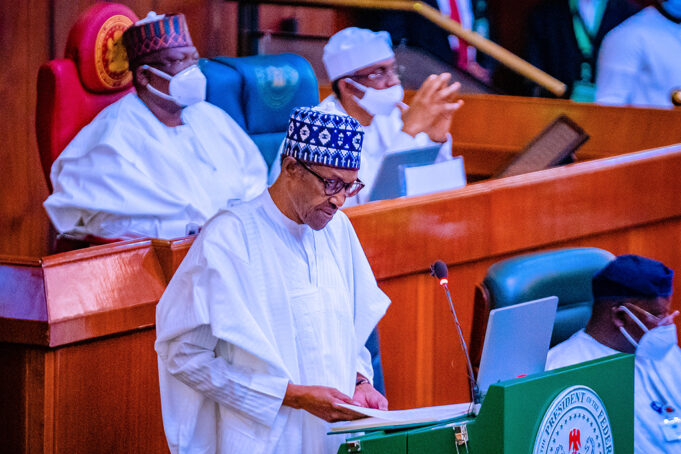President Muhammadu Buhari on Thursday explained how his government would finance the N6.26 trillion deficit in the 2022 Budget.
Buhari while presenting the document titled “Budget of Economic Growth and Sustainability” to the Joint Session of the National Assembly today in Abuja, also justified why his government has resorted to borrowing in financing critical infrastructure development.
“We plan to finance the deficit mainly by new borrowings totalling N5.01 trillion, N90.73 billion from Privatization Proceeds and N1.16 trillion drawdowns on loans secured for specific development projects,” he said.
A total expenditure of N16.39 trillion is proposed for the Federal Government in 2022. The proposed expenditure comprises: Statutory Transfers of N768.28 billion; Non-debt Recurrent Costs of N6.83 trillion; Personnel Costs of N4.11 trillion; Pensions, Gratuities and Retirees’ Benefits N577.0 billion; Overheads of N792.39 billion; Capital Expenditure of N5.35 trillion, including the capital component of Statutory Transfers; Debt Service of N3.61 trillion; and Sinking Fund of N292.71 billion to retire certain maturing bonds.
Buhari stated that based on fiscal assumptions and parameters, total federally-collectible revenue is estimated at N17.70 trillion in 2022.
Also, total federally distributable revenue is estimated at N12.72 trillion in 2022 while total revenue available to fund the 2022 Federal Budget is estimated at N10.13 trillion. This includes Grants and Aid of N63.38 billion as well as the revenues of 63 Government-Owned Enterprises.
Oil revenue is projected at N3.16 trillion, Non-oil taxes are estimated at N2.13 trillion and FGN Independent revenues are projected to be N1.82 trillion.
According to him, “We expect the total fiscal operations of the Federal Government to result in a deficit of N6.26 trillion. This represents 3.39 per cent of estimated GDP, slightly above the 3 per cent threshold set by the Fiscal Responsibility Act 2007. Countries around the world have to of necessity over-shoot their fiscal thresholds for the economies to survive and thrive
“We need to exceed this threshold considering our collective desire to continue tackling the existential security challenges facing our country.”
On the resort to borrowing, the President said: “Some have expressed concern over our resort to borrowing to finance our fiscal gaps. They are right to be concerned. However, we believe that the debt level of the Federal Government is still within sustainable limits. Borrowings are to specific strategic projects and can be verified publicly.
“As you are aware, we have witnessed two economic recessions within the period of this Administration. In both cases, we had to spend our way out of recession, which necessitated a resort to growing the public debt. It is unlikely that our recovery from each of the two recessions would have grown as fast without the sustained government expenditure funded by debt.
“Our target over the medium term is to grow our Revenue-to-GDP ratio from about 8 per cent currently to 15 per cent by 2025. At that level of revenues, the Debt-Service-to-Revenue ratio will cease to be worrying. Put simply, we do not have a debt sustainability problem, but a revenue challenge which we are determined to tackle to ensure our debts remain sustainable.
“Very importantly, we have endeavoured to use the loans to finance critical development projects and programmes aimed at improving our economic environment and ensuring effective delivery of public services to our people.”
According to him, the funds would be used in the completion of major road and rail projects; effective implementation of power sector projects; provision of potable water; construction of irrigation infrastructure and dams across the country; and critical health projects.
The 2022 to 2024 Medium Term Expenditure Framework and Fiscal Strategy Paper sets out the parameters for the 2022 Budget as follows:
- Conservative oil price benchmark of $57 per barrel;
- Daily oil production estimate of 1.88 million barrels (inclusive of Condensates of 300,000 to 400,000 barrels per day);
- Exchange rate of four 410.15 per US Dollar; and
- Projected GDP growth rate of 4.2 percent and 13 percent inflation rate.
The President noted that the 2022 Budget will be the last full year budget to be implemented by this administration.
“We designed it to build on the achievements of previous budgets and to deliver on our goals and aspirations as will be reflected in our soon-to-be launched National Development Plan of 2021 to 2025,” he noted.
The President stated that the allocations to MDAs were guided by the strategic objectives of the National Development Plan of 2021 to 2025, which are: a. Diversifying the economy, with robust MSME growth; b. Investing in critical infrastructure; c. Strengthening security and ensuring good governance; d. Enabling a vibrant, educated and healthy populace; e. Reducing poverty; and f. Minimizing regional, economic and social disparities.
- 2030: World Bank, AfDB partner to connect 300m Africans to electricity - April 17, 2024
- UK Court fines Nigerian nurse over forgery of emergency health badge - March 4, 2024
- Inferno: Churches, pastors, others rally support for Household of David - February 7, 2024










